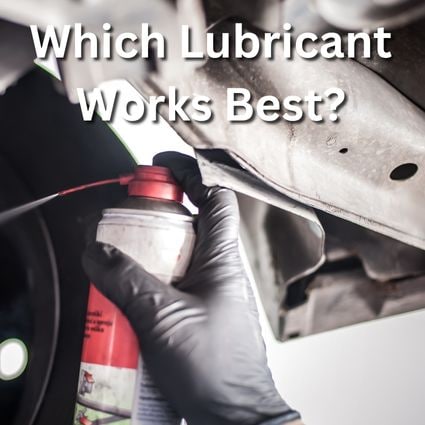DIY Lubrication Tips: Keeping Your Car’s Doors, Locks & Hinges Moving Smoothly in Vermont
When hinges dry out or locks attract moisture, you can end up with:
- Doors that creak, grind, or feel stiff
- Locks that freeze in cold weather
- Gas tank doors that won't pop open
- Hood or trunk latches that get stuck
A little preventative lubrication goes a long way-saving time, frustration, and even repair costs down the road.
🚗 Why Lubricating Locks & Hinges Matters in Vermont
Here in Central Vermont, your vehicle's doors, locks, and hinges have to deal with:
- Road salt and brine
- Moisture and slush
- Freeze-thaw cycles all winter long
- Dirt and grit from back roads and driveways
All of that can cause corrosion, sticking, squeaking, or outright failure of door hinges, lock cylinders, and latches. Keeping these parts lubricated helps your doors open and close smoothly, cuts down on embarrassing squeaks in the grocery store parking lot, and reduces the chance that a frozen lock or stuck hood latch will ruin your day.
🔧 Understanding the Four Main Types of Lubricants
WD-40 & Similar Penetrating Oils
WD-40 wasn't originally designed as a lubricant. Its name stands for Water Displacement, 40th Formula, and it was created to push moisture out of tight spaces and help prevent rust.
Pros:
- Excellent at displacing moisture
- Helps break up rust and grime
- Good for cleaning out sticky mechanisms
Cons:
- Not a true long-term lubricant
- Can attract dust and dirt over time
- Not ideal as the final treatment for hinges or locks
Think of WD-40 as a cleaner and moisture remover, not the final lubricant you want to leave on your door hinges or locks.
Graphite Lubricants
Graphite is a dry powder lubricant. It doesn't dry out, doesn't thicken, and doesn't attract dirt the way oily sprays can.
Pros:
- Excellent for keyholes and lock tumblers
- Works very well in freezing temperatures
- Long-lasting and stable
Cons:
- Can be messy if over-applied
- Not suitable for exposed hinges or sliding metal surfaces
Graphite is the gold standard for lock cylinders, especially during Vermont winters.
Silicone Sprays
Silicone sprays work well for lighter mechanisms and components that involve plastic or rubber.
Pros:
- Repels water
- Does not attract dirt as much as some oils
- Safe for paint, plastic, and rubber parts
Cons:
- Not ideal for heavy-load metal hinges
- May not last as long on high-stress contact points
Silicone is a great all-purpose spray, especially for gas tank doors, latches, and rubber weatherstripping.
White Lithium Grease
White lithium grease is a thicker, long-lasting lubricant designed for metal-on-metal contact points.
Pros:
- Excellent for hinges and high-friction joints
- Stays in place longer than light sprays
- Handles Vermont's cold and road spray well
Cons:
- Too heavy and sticky for lock cylinders
- Can be messy if you apply too much
This is your best friend for door hinges, hood hinges, and trunk hinges when used sparingly and correctly.

🚪 The Best Lubricant for Each Part of Your Car
Door Locks (Keyholes & Internal Lock Cylinders)
Best choice: Graphite lubricant.
Graphite stays dry, doesn't gum up, and won't attract dirt and grit inside the lock cylinder. It also continues to perform well in freezing temperatures, making it ideal for Vermont winters.
WD-40 Tip: If your lock is already wet, sticky, or showing signs of freezing, a quick shot of WD-40 can help clear out moisture and grime. After that, it's a good idea to follow up with graphite for long-term lubrication.
Door Hinges
Best choice: White lithium grease.
Door hinges carry the weight of your doors and see a lot of movement. Lithium grease offers long-lasting lubrication and protection against rust and wear. It also tends to stay put, even when you're dealing with snow, slush, and car washes around Montpelier and Barre.
Hood & Trunk Hinges and Latches
Best choice: White lithium grease for the hinges, and a light application of lithium or silicone spray for the latch mechanism.
The hood and trunk hinges work just like door hinges, so lithium grease is ideal. For the latch itself-the part that actually catches and holds-you can use a lighter coat of lithium or silicone spray to keep things moving freely without creating a greasy mess.
Gas Tank Doors
Best choice: Silicone spray.
Gas tank doors usually involve a combination of paint, plastic, and lighter metal parts. Silicone spray is gentle, helps repel moisture, and prevents sticking or freezing. It's a simple way to keep your fuel door popping open smoothly when it's below zero outside.
🧰 Quick Step-by-Step Lubrication Guide
Door Locks
- Spray a short puff of graphite into the keyhole.
- Insert the key and turn it several times to work the lubricant through the cylinder.
- Wipe any excess graphite from the key and surrounding paint.
Door Hinges
- Open the door and wipe the hinge area with a clean rag to remove dirt and old buildup.
- Apply a small bead of white lithium grease to the hinge pivot points.
- Open and close the door several times to distribute the grease.
Hood & Trunk Hinges
- Support the hood or trunk safely.
- Apply white lithium grease to the visible hinge joints.
- Use a light spray of silicone or a small amount of lithium on the latch mechanism.
- Open and close a few times to ensure smooth operation.
Gas Tank Door
- Open the gas tank door.
- Spray a small amount of silicone on the hinge area and latch tab.
- Wipe away any overspray from the body and fuel door.
❄️ Why This Matters Even More in Montpelier & Barre
From December through March, Vermont sees dramatic freeze-thaw cycles. Moisture seeps into hinges and locks during the day, then freezes overnight. Add in road salt, and you've got a perfect recipe for corrosion and sticking components.
Lubricating your doors and locks is a simple DIY job that helps prevent:
- Frozen or jammed locks
- Stuck or noisy door hinges
- Gas doors that won't open
- Hood latches that won't release
- Premature wear and costly repairs
Drivers from Montpelier, Barre, Berlin, Northfield, and Williamstown deal with these conditions every winter, so a bit of extra attention now can save a lot of hassle later.
🔧 DIY vs. When to Visit Our Service Department
Lubricating locks and hinges is a great DIY maintenance task, but there are times when it makes sense to have a professional take a look. You should visit Central Vermont Auto Mart in Montpelier if you notice:
- Doors that grind or bind even after lubrication
- Locks that still feel tight, jammed, or won't turn
- Hood release cables that feel stiff or don't fully release the hood
- A door that has started to sag or doesn't line up properly
- Trunk or hatch doors that won't stay open or latch securely
Our service team can inspect the hinges, locks, cables, and latches to make sure everything is safe and working correctly-especially important before winter fully sets in.
📅 Final Seasonal Maintenance Tips
For best results, plan to lubricate your doors, locks, and hinges:
- Twice a year as part of your regular maintenance
- Before winter to prepare for freezing temperatures
- After several car washes or heavy exposure to road salt and slush
- Anytime you start hearing new squeaks, clicks, or grinding noises
You can also pair this simple DIY job with other seasonal services like winter tire installation, brake inspections, and battery checks for added peace of mind.
☝️ Wrapping it Up
Keeping your vehicle's doors, locks, and hinges properly lubricated is one of the easiest ways to prevent winter breakdowns and extend the life of moving parts. If you need help or want a professional inspection, the team at Central Vermont Auto Mart in Montpelier is here to help drivers from Barre, Berlin, Northfield, and Williamstown stay safe on the road.
 Published November 17, 2025
Published November 17, 2025

